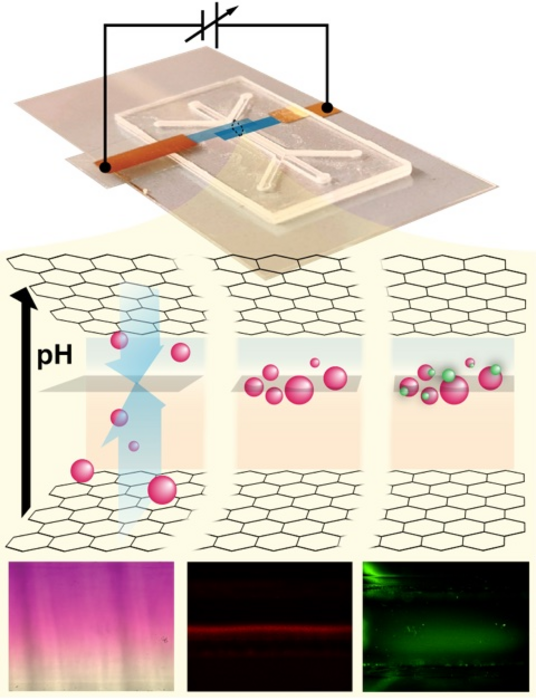Reviewed by Alex SmithJul 19 2022
The biggest challenge in isolating and identifying molecules in a microdevice has been overcome by assistant professor Jinglei Ping from the University of Massachusetts Amherst.
 A stable pH gradient is generated between a pair of biased graphene microelectrodes. Molecules (red particles) are focused into a narrow band—the focusing plane—between the microelectrodes upon the pH-gradient generation. The focused molecules are detected at high sensitivity by pre-placing specific recognizers (green particles) at the focusing plane. Image Credit: University of Massachusetts Amherst
A stable pH gradient is generated between a pair of biased graphene microelectrodes. Molecules (red particles) are focused into a narrow band—the focusing plane—between the microelectrodes upon the pH-gradient generation. The focused molecules are detected at high sensitivity by pre-placing specific recognizers (green particles) at the focusing plane. Image Credit: University of Massachusetts Amherst
The study, which was recently published in ACSNano, shows a significant advancement in the use of graphene for electrokinetic biosample analysis and processing, and it could enable lab-on-a-chip devices to become smaller and accomplish quick results.
The detection of biomolecules has traditionally been considered a difficult and time-consuming process.
We usually first have to isolate them in a complex medium in a device and then send them to another device or another spot in the same device for detection.
Jinglei Ping, Assistant Professor, Mechanical and Industrial Engineering, College of Engineering, University of Massachusetts Amherst
Ping is also affiliated with the university’s Institute of Applied Life Sciences. “Now we can isolate them and detect them at the same microscale spot in a microfluidic device at the same time — no one has ever demonstrated this before.”
His lab made this breakthrough by employing graphene, a one-atom-thick honeycomb lattice of carbon atoms, as microelectrodes in a microfluidic device.
We found that, compared to typical inert-metal microelectrodes, the electrolysis stability for graphene microelectrodes is more than 1,000 times improved, making them ideal for high-performance electrokinetic analysis.
Jinglei Ping, Assistant Professor, Mechanical and Industrial Engineering, College of Engineering, University of Massachusetts Amherst
Ping also stated that because monolayer graphene is transparent, “we developed a three-dimensional multi-stream microfluidic strategy to microscopically detect the isolated molecules and calibrate the detection at the same time from a direction normal to the graphene microelectrodes.”
According to Ping, the novel strategy developed in the work lays the foundation the way for the development of lab-on-a-chip devices with maximum time and size efficiencies. Furthermore, the method is not limited to analyzing biomolecules — it could be used to separate, identify, and stimulate microorganisms like cells and bacteria.
Co-authors of the paper are Ping’s students — Xiao Fan (first author) and Xiaoyu Zhang.
The Air Force Office of Scientific Research (AFOSR) has funded Ping’s research through the 2020 Young Investigator Program (YIP). The YIP project of Ping aims to create innovations for long-term, high-spatiotemporal resolution, high-sensitivity electrical detection, and stimulation of large-scale biosystems.
Journal Reference:
Fan, X., et al. (2022) Graphene-Enabled High-Performance Electrokinetic Focusing and Sensing. ACS Nano. doi.org/10.1021/acsnano.2c03054.